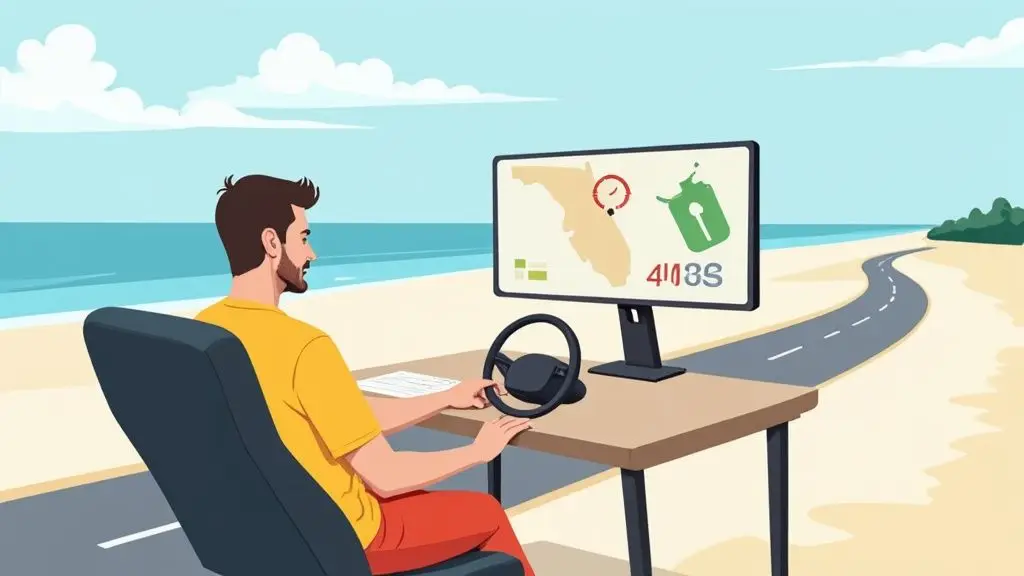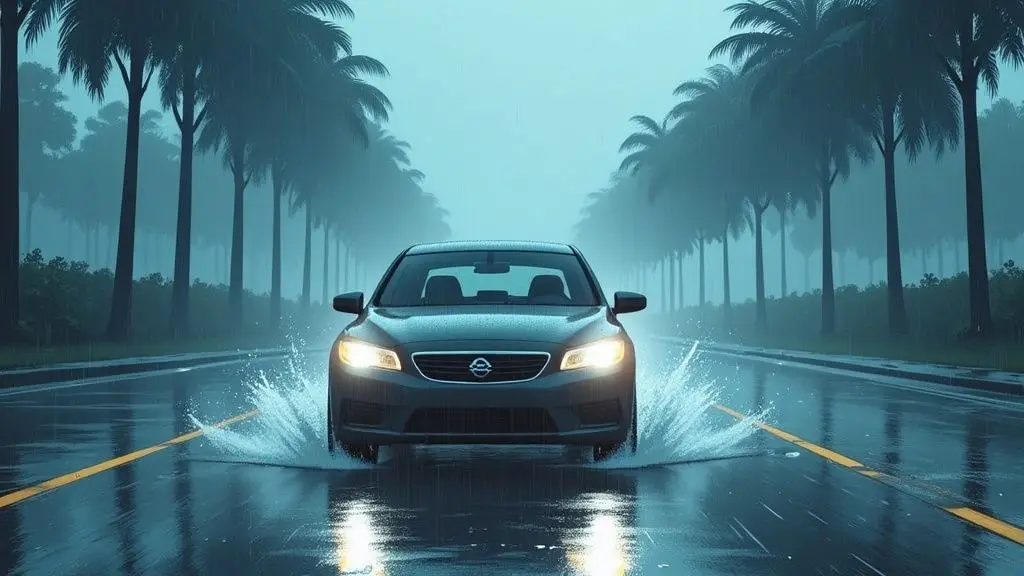Parking lots are a universal part of our daily lives, yet they account for a disproportionate number of accidents and crimes. Approximately one in five vehicle collisions occur in these seemingly low-risk environments, and thousands of personal property crimes are reported in them annually. This guide moves beyond the obvious advice, offering a comprehensive set of strategic parking lot safety tips designed for modern drivers navigating these common spaces. By understanding the psychology of both safety and crime, you can transform these transitional areas from zones of vulnerability into zones of control.
We will explore proactive measures that empower you, from selecting the right parking spot to mastering the art of situational awareness. These actionable insights are crucial for anyone looking to enhance their personal security and driving skills, aligning with the principles taught in advanced driver improvement courses. This guide focuses on what you can control, but understanding broader proactive parking lot security measures, often employed by property managers, can further enrich your approach to safety in these spaces. The following tips will ensure you are prepared and confident every time you park, minimizing risk and maximizing your personal security.
1. Stay Alert and Minimize Distractions
The single most effective tool in your safety arsenal is your own awareness. Parking lots are uniquely dynamic environments where vehicles and pedestrians constantly intersect, often in unpredictable ways. Maintaining situational awareness means actively dedicating your full attention to your surroundings, a practice that is fundamentally incompatible with common distractions like mobile phones, headphones, or in-depth conversations.
Distraction isn’t just a problem for drivers; it’s a significant risk for pedestrians as well. When you walk through a parking lot with your head down, scrolling through emails or replying to a text, you become oblivious to reversing cars, moving traffic, and other potential hazards. This is why major retailers like Target and Walmart have invested in signage campaigns to remind shoppers to look up from their devices. Similarly, university campuses, such as Penn State, run awareness programs to highlight these exact dangers to their student body.
Why It’s a Top Priority
The seemingly low-speed nature of a parking lot can create a false sense of security, yet the statistics tell a different story. These areas are hotspots for collisions and pedestrian incidents precisely because attention levels drop.
The following infographic highlights just how prevalent these risks are, visualizing key data on parking lot accidents and distracted walking injuries.
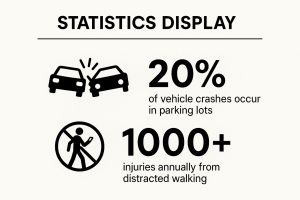
These numbers underscore the critical importance of treating parking facilities as high-risk zones that demand your undivided attention.
Actionable Tips for Staying Focused
To make this one of the most effective parking lot safety tips you follow, integrate these habits into your routine:
- Establish a “No-Phone Zone”: Put your phone away before you exit your vehicle or enter the parking lot on foot. Finish your calls, texts, and navigation setup before you start moving.
- Use Your Senses: Remove headphones or earbuds. Being able to hear an engine, a car horn, or another person’s warning can prevent an accident.
- Scan and Connect: Regularly scan your surroundings in a 360-degree pattern. Before crossing a lane, try to make eye contact with drivers to confirm they have seen you.
- Practice Mindful Movement: Treat walking through a parking lot with the same focus you would apply to crossing a busy street. The principles of attentiveness are identical and just as crucial for your safety. To better understand the risks associated with inattention, you can explore resources covering the dangers of distracted driving and walking. For more details on this topic, learn about distracted driving awareness.
2. Park in Well-Lit, Visible Areas
Choosing your parking space is a proactive safety measure, not just a matter of convenience. Parking in a well-illuminated and highly visible area is a fundamental crime prevention strategy that significantly enhances personal safety. Bright, consistent lighting deters potential criminals who rely on darkness and concealment, while simultaneously improving visibility for both drivers and pedestrians, which helps prevent accidental collisions.
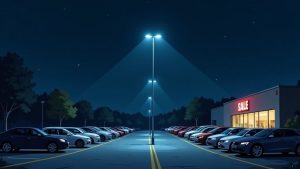
This approach is a core principle of Crime Prevention Through Environmental Design (CPTED), a methodology proven to reduce criminal opportunities by modifying the built environment. Prominent organizations like the National Crime Prevention Council champion this tactic, and its effectiveness is seen in the design of modern facilities. For instance, major shopping centers managed by Simon Property Group and hospital campuses like the Mayo Clinic have invested heavily in upgrading to bright LED lighting systems, often integrated with security cameras, to create safer environments for visitors and staff.
Why It’s a Top Priority
A poorly lit or isolated parking spot creates an ideal environment for theft, vandalism, or personal assault. Criminals actively seek out areas with low visibility and minimal foot traffic to reduce their chances of being seen. By intentionally selecting a spot near a store entrance, under a bright light, or within view of security cameras, you actively remove the element of concealment that potential offenders depend on. This simple choice transforms your vehicle from an easy target into a less appealing one.
Actionable Tips for Choosing Your Spot
To make this one of the most effective parking lot safety tips you practice, always prioritize visibility when selecting a space:
- Arrive with a Plan: If you know you’ll be returning to your car after dark, make a conscious effort to park under a light source, even if it’s daytime when you arrive.
- Avoid Visual Obstructions: Steer clear of parking next to large vehicles like vans or trucks, as well as near dense shrubbery or dumpsters. These create significant blind spots that can conceal someone from view.
- Prioritize Proximity and Traffic: Choose a space closer to the store’s entrance or a main pedestrian walkway. The increased foot traffic and natural surveillance from other people provide an additional layer of security.
- Look for Security Features: Park near marked security patrol routes, emergency call boxes, or in direct line-of-sight of security cameras whenever possible. The principles of staying visible are crucial, especially after sundown. For more guidance on navigating safely in low-light conditions, explore these night driving tips.
3. Have Your Keys Ready Before Approaching Your Vehicle
The moments spent searching for your keys at your car door represent a critical window of vulnerability. Preparing your keys or key fob well before you reach your vehicle is a simple, proactive step that dramatically reduces this exposure, allowing for swift entry and a quick exit from a potentially dangerous situation. This isn’t just a matter of convenience; it’s a foundational personal security practice.
This technique is so effective that it’s a cornerstone of safety training across various sectors. Corporate security programs, such as those at major logistics companies, include it in employee safety protocols. Self-defense instructors like Gabrielle Rubin consistently emphasize this habit in their parking lot safety courses, and campus police departments nationwide integrate it into student safety orientations. It’s a universally recognized tactic for minimizing risk by reducing loitering time.
Why It’s a Top Priority
Fumbling for keys at your vehicle door signals a lack of awareness and preoccupation, making you an attractive target for opportunistic criminals. Having your keys in hand demonstrates preparedness and allows you to access the safety of your locked car in seconds. It shifts you from a state of being distracted and vulnerable to one of being ready and in control of your immediate environment.
This simple habit can be the difference between a seamless exit and a dangerous encounter. It is one of the most powerful yet effortless parking lot safety tips to adopt because it directly addresses the element of surprise that assailants often rely on.
Actionable Tips for Key Preparedness
To make this a reflexive safety habit, incorporate these practices into your routine:
- Designate an Accessible Spot: Store your keys in a consistent, easily reachable location, like a specific coat pocket, rather than at the bottom of a purse or backpack.
- Prepare Before You Exit: Have your keys in your hand before you leave the building and begin walking through the parking lot.
- Utilize Your Key Fob: Use the remote unlock button as you approach your vehicle to have the door ready the moment you arrive. Familiarize yourself with the location of the panic button for emergencies.
- Manage Your Belongings: If your hands are full with packages or bags, briefly set them down on the hood or trunk of your car to unlock the door, rather than trying to juggle everything at once.
4. Check Around and Under Your Vehicle Before Approaching
One of the most powerful habits for personal security is performing a visual inspection of your vehicle and its immediate surroundings before you get close. This proactive scan is designed to identify potential threats, such as a person hiding between or under cars, before you are within arm’s reach and in a vulnerable position. This method is not paranoia; it’s a strategic safety protocol adapted from law enforcement and military training for everyday civilian use.
This practice is emphasized by security consultants like Gavin de Becker and taught in self-defense programs because it shifts you from being a potential target to being an observer in control of your environment. Corporate security programs at major companies and even hotel valet services train staff to perform similar checks, underscoring its effectiveness in a variety of settings.
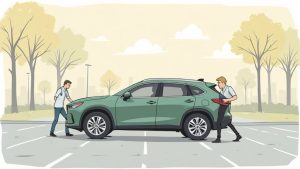
Why It’s a Top Priority
An attacker’s greatest advantage is the element of surprise. By visually clearing the area around your car from a distance, you deny them that advantage. This simple act gives you crucial seconds to react: you can retreat to a safer, more populated area, alert security, or call for help without ever engaging the potential threat. This habit is a fundamental component of proactive self-protection.
This preemptive check also helps prevent non-malicious accidents, such as backing over forgotten items, broken glass, or even small animals that may have sought shelter underneath your car. It’s a comprehensive approach to safety that covers both personal security and vehicle awareness.
Actionable Tips for Vehicle Approach
To turn this into one of your most effective parking lot safety tips, integrate these specific actions into your routine every time you approach your vehicle:
- Scan from a Distance: Begin your visual sweep when you are still 20-30 feet away. Look for anything that seems out of place around your car and in the adjacent spaces.
- Check Low and High: Specifically look for feet or shadows under your vehicle and neighboring cars. Glance through your windows to check the backseat and passenger-side floor before you unlock the doors.
- Use Reflections: Your car’s windows and mirrors can act as tools. Use their reflections to see around corners and check blind spots without exposing yourself.
- Trigger Interior Lights: If it’s dark, use your key fob to unlock and immediately relock your doors. This will trigger the interior lights, illuminating the inside for a quick, safe inspection from afar.
- Trust Your Instincts: If something feels wrong or a person’s presence near your car makes you uneasy, do not approach. Your intuition is a powerful safety tool. Walk away and seek assistance.
This practice of situational awareness extends to the condition of your car as well; a well-maintained vehicle is a safer one. To better understand preventative care, explore this guide on essential Florida vehicle maintenance.
5. Walk Confidently and Stay in Designated Pedestrian Areas
How you carry yourself and the path you choose to walk are powerful, yet often overlooked, safety tools in a parking lot. Maintaining confident body language, such as walking with your head up and maintaining a purposeful stride, makes you appear more aware and less like an easy target for potential criminals. This concept, supported by personal safety experts like Kelly Sundberg Seaman, suggests that projecting awareness can act as a deterrent.
This proactive posture goes hand-in-hand with using designated pedestrian areas. Sticking to marked crosswalks and pathways significantly reduces the risk of an accident by placing you where drivers expect to see pedestrians. Large retailers and high-traffic venues understand this principle. For instance, IKEA often uses bright blue pedestrian pathways, while major airports like LAX have elevated walkways to physically separate people from traffic, demonstrating a commitment to pedestrian safety.
Why It’s a Top Priority
Combining confident movement with the use of designated paths addresses two primary parking lot dangers simultaneously: vehicle collisions and personal threats. When you cut between parked cars, you become invisible to drivers who may be backing out or turning. At the same time, a hesitant or distracted posture can signal vulnerability.
The following image illustrates a well-marked pedestrian zone, highlighting the kind of infrastructure designed to keep you safe and visible.
Adopting these habits transforms you from a passive participant into an active manager of your own safety, a critical mindset for navigating any busy environment.
Actionable Tips for Safe Movement
To ensure this becomes one of the most effective parking lot safety tips you implement, integrate these practices into your routine:
- Project Confidence: Walk with your head up and shoulders back at a steady, purposeful pace. This posture communicates awareness and self-assurance.
- Use Designated Paths: Always use marked crosswalks and walkways, even if it adds a few extra steps. Avoid the temptation to take shortcuts between parked vehicles.
- Stay Centered: When on a pedestrian path, walk in the center to maintain a safe distance from cars on either side.
- Be Visible: If walking at dusk or at night, wear bright or reflective clothing to increase your visibility to drivers.
- Mind Your Surroundings: Make eye contact with drivers before crossing their path to confirm they see you. If walking with children, hold their hands and keep them close.
6. Trust Your Instincts and Report Suspicious Activity
Intuition is a powerful safety tool, a primitive warning system that processes environmental cues much faster than your conscious mind can. If something or someone in a parking lot makes you feel uneasy, that feeling should never be ignored. This principle, heavily emphasized by security experts like Gavin de Becker in his book ‘The Gift of Fear’, acknowledges that humans have evolved threat-detection systems that often register danger before we can articulate why.
This “gut feeling” is your mind noticing subtle anomalies, such as someone loitering without purpose, a vehicle that seems out of place, or an individual paying too much attention to shoppers. Acting on this instinct by reporting suspicious activity contributes to a collective safety net. Venues like the Mall of America empower visitors with “See Something, Say Something” programs that include simple text-to-security options, turning individual awareness into a community-wide asset. Similarly, many university campuses, like UC Berkeley, have installed emergency phones with direct lines to security, encouraging immediate reporting.
Why It’s a Top Priority
Ignoring your intuition out of politeness or a desire not to overreact can have serious consequences. Security professionals and law enforcement consistently advise the public to trust their instincts because that internal alarm is often the first and only sign that a situation is escalating toward a potential crime, such as a robbery, assault, or vehicle break-in.
Confrontation is not the goal; communication with authorities is. Reporting suspicious behavior allows trained personnel to assess and manage the situation safely. Your prompt report could prevent a crime from happening to you or someone else.
Actionable Tips for Acting on Intuition
To make this one of the most effective parking lot safety tips you implement, integrate these habits into your parking routine:
- Never Dismiss Unease: If you feel you are being watched or a situation seems “off,” act immediately. Return to the store or a well-lit, populated area.
- Report, Don’t Confront: Your safety is paramount. Do not approach or confront a suspicious individual yourself. Instead, contact facility security or call 911 from a safe location. This is crucial for avoiding escalation; to better understand how to de-escalate potential conflicts, you can learn how to handle aggressive drivers.
- Be a Good Witness: If you report something, provide clear details: a description of the person, their clothing, their location, and the specific behavior you observed. Note the make, model, and license plate of any involved vehicles if you can do so safely.
- Prepare for Contingencies: Even with diligent attention, accidental lockouts can happen, leaving you vulnerable. Knowing who to call for professional car lockout services in advance can minimize your time spent in a potentially unsafe situation.
7. Lock Doors Immediately Upon Entering and Exiting
The brief moment between getting into your car and starting the engine, or parking and getting out, creates a significant window of vulnerability. Locking your doors immediately upon entering and exiting is a simple, non-negotiable habit that acts as a powerful deterrent against unauthorized entry, theft, and carjackings. This quick action transforms your vehicle from an accessible target into a secure barrier.
This principle is so fundamental that it forms the bedrock of vehicle security protocols taught by law enforcement and integrated into driver safety programs. For instance, rideshare companies like Uber and Lyft emphasize immediate door locking as a core safety standard for their drivers. Similarly, major auto manufacturers, including Toyota and Honda, now commonly include automatic locking features that activate once the car is in motion or the key fob moves a certain distance away, recognizing the critical nature of this security layer.
Why It’s a Top Priority
An unlocked door is an open invitation for criminals. Many vehicle-related crimes are crimes of opportunity, and the few seconds your doors are unlocked are all an assailant needs. The National Highway Traffic Safety Administration (NHTSA) frequently highlights that consistent locking habits could prevent a substantial number of these incidents, reinforcing that this small action has a major impact on personal safety.
Locking your doors instantly removes the element of surprise an attacker might rely on. It provides you with crucial time to assess a situation, start your vehicle, and drive away from a potential threat. For anyone concerned with parking lot safety tips, making this an automatic reflex is one of the most effective personal security measures you can adopt.
Actionable Tips for Securing Your Vehicle
Integrate these practices to ensure your vehicle is always a secure space:
- Create a Reflex: Make hitting the lock button the very first thing you do after closing your door, whether you are inside or outside the vehicle.
- Enable Auto-Lock Features: Dive into your vehicle’s settings and activate any automatic door-locking features. This provides a valuable backup if you forget to do it manually.
- Verify Before Driving: Before putting the car in gear, glance at your door locks to confirm they are all engaged.
- Teach Everyone: If you regularly travel with family, teach children and other passengers to lock their door as soon as they get in.
- Assess Before Unlocking: When returning to your car, scan your surroundings before you use your key fob to unlock the doors. Don’t unlock them until you are right next to the vehicle and ready to enter.
- Stay Secure if Approached: If a suspicious person approaches your vehicle, your locked doors are your first line of defense. Do not roll down your window; honk your horn and drive away if it is safe to do so.
8. Avoid Parking Next to Large Vehicles and in Isolated Spots
The spot you choose to park in can dramatically influence your personal safety. Strategic selection involves more than just proximity to your destination; it’s about maximizing visibility and minimizing opportunities for potential threats. Parking next to large vehicles like vans, trucks, or SUVs creates significant blind spots and provides concealment for would-be attackers. Similarly, choosing an isolated spot far from entrances or other cars increases your vulnerability by removing the potential for witnesses.
This strategy is a cornerstone of crime prevention taught by law enforcement and security professionals. For instance, the NYPD frequently includes warnings about parking next to windowless vans in its public safety campaigns. On college campuses, such as Michigan State University, this advice is a standard part of student safety orientations. The goal is to create an environment where you are clearly visible from the moment you exit your vehicle until you reach the building.
Why It’s a Top Priority
Parking next to a large vehicle obstructs your view of the surrounding area and, more importantly, obstructs others’ view of you. This cover allows a potential assailant to wait unnoticed. When you return, you have no way of knowing if someone is hidden on the other side of that vehicle. Isolated spots carry a similar risk, as the lack of foot traffic and other drivers means there is a lower chance of a Good Samaritan intervening or being able to provide a witness account if something happens.
Choosing a spot in a moderately populated area, often called the ‘Goldilocks zone’, strikes the perfect balance. It’s not so crowded that navigating is difficult, but not so empty that you are left alone and vulnerable. This thoughtful approach to parking is one of the most proactive parking lot safety tips you can adopt.
Actionable Tips for Smart Parking
Integrate these habits to enhance your safety through strategic parking selection:
- Avoid End Spots and Corners: Park in the middle of a row when possible. End spots and corners are more isolated and can limit your potential escape routes if you are confronted.
- Target the ‘Goldilocks Zone’: Look for a space that is neither completely isolated nor chaotically crowded. Aim for an area with a steady, but not overwhelming, flow of people and vehicles.
- Beware of Large Vehicles: Make a conscious effort to avoid parking next to oversized trucks, commercial vans (especially those without windows), or any vehicle that blocks your line of sight.
- Pull Through When Possible: If the parking lot design allows, choose a spot where you can pull through, so your car is facing forward for a quick and easy exit. This eliminates the need to reverse, a time when your attention is divided.
- Choose Visibility Over Convenience: An extra 30 seconds of walking from a well-lit, visible spot is a small price to pay for increased safety. Never sacrifice visibility for a slightly closer, but more secluded, parking space.
Parking Lot Safety Tips Comparison Table
| Safety Strategy | Implementation Complexity 🔄 | Resource Requirements ⚡ | Expected Outcomes 📊 | Ideal Use Cases 💡 | Key Advantages ⭐ |
|---|---|---|---|---|---|
| Stay Alert and Minimize Distractions | Moderate – requires constant mental focus | Low – personal discipline only | Reduced accident risk, faster reaction times, better safety | Busy parking lots, high pedestrian-vehicle interaction | Significantly lowers accidents, early hazard identification |
| Park in Well-Lit, Visible Areas | Low – selecting spots based on environment | Low to moderate – depends on parking | Reduced theft/assault risk, better visibility at night | Nighttime parking, high-crime areas | Deters crime, improves monitoring and personal safety |
| Have Your Keys Ready Before Approaching Vehicle | Low – simple habit, minimal extra steps | Low – only personal preparation | Reduced vulnerability time, quick escapes | Anytime approaching vehicle, busy or isolated lots | Enables quick entry, prevents fumbling, supports panic use |
| Check Around and Under Your Vehicle Before Approaching | Moderate – requires time and vigilance | Low – personal visual inspection | Early threat detection, prevents attacks and tampering | Parking in unfamiliar or high-risk areas | Identifies hidden threats, vehicle tampering awareness |
| Walk Confidently and Stay in Designated Pedestrian Areas | Moderate – requires behavioral adjustment | Low – personal behavior | Greater visibility, reduced collision risk, deters attackers | All parking lots, especially busy or poorly lit zones | Increases safety via visibility and confidence projection |
| Trust Your Instincts and Report Suspicious Activity | Low – based on intuition, prompt reaction | Low – requires awareness and communication | Early crime prevention, community safety enhancement | All environments, locations with security personnel | Empowers personal protection, prevents crimes via reporting |
| Lock Doors Immediately Upon Entering and Exiting | Low – simple habit | Low – enabled by vehicle tech | Prevents carjackings, theft, adds physical security | All vehicle parking scenarios | Blocks unauthorized entry, reduces grab-and-run risks |
| Avoid Parking Next to Large Vehicles and in Isolated Spots | Moderate – requires careful parking choice | Low – depends on lot layout availability | Reduces concealment chances, improves visibility | All parking areas, especially large or isolated lots | Enhances visibility, deters attackers, safer vehicle access |
Putting It All Together: Your Blueprint for Safer Parking
Navigating a parking lot safely isn’t about mastering a single trick; it’s about developing a consistent, multi-layered safety mindset. The eight strategies we’ve explored serve as the fundamental building blocks for this proactive approach. By weaving them into your daily routine, you transform a potentially vulnerable moment into a controlled, secure experience. Each tip acts as a reinforcing layer of protection, working in concert with the others to significantly reduce your risk of accidents, theft, or personal harm.
Think of it as a personal safety system. Staying alert and minimizing distractions is your first line of defense, creating the foundation of awareness. Choosing a well-lit, visible parking spot is your strategic positioning, making you a less appealing target. Having your keys ready, checking your surroundings, and locking your doors immediately are your tactical actions, minimizing windows of opportunity for criminals. These are not just individual items on a checklist; they are interconnected habits that create a powerful, cumulative effect.
From Habit to Instinct
The ultimate goal is to move these practices from conscious thought to automatic behavior. Initially, you may need to remind yourself to look under your vehicle or to consciously choose a spot near a light source. Over time, however, these actions become second nature. This is where true security lies, when your safety protocols are so ingrained that they become instinctual. You start to notice things you previously overlooked, a person lingering too long near a car, an unusually dark corner of a garage, or the feeling that something just isn’t right.
This heightened awareness is one of the most valuable takeaways from these parking lot safety tips. It extends beyond the parking lot and into all aspects of your driving life. It empowers you to take control, to trust your judgment, and to act decisively to protect yourself and your property. Remember, your personal safety is an active process, not a passive hope. It’s a skill you can build, refine, and strengthen with every trip you take.
Your Next Step in Total Driver Safety
Mastering these concepts demonstrates a commitment to becoming a more responsible and defensive driver. You understand that safety isn’t just about what happens on the main road; it’s about the entire journey from start to finish. This holistic view is crucial, especially for Florida drivers navigating increasingly busy roads and public spaces. By applying these parking lot safety tips, you are not just preventing a potential crime; you are honing the defensive driving skills that keep you and others safe in every scenario. The confidence gained from knowing you are prepared for any situation is invaluable, turning anxiety into empowerment.
Ready to take your commitment to safety to the next level? Sharpen your defensive driving skills and deepen your understanding of traffic laws with BDISchool, Florida’s trusted online traffic school. Our state-approved courses are designed to make you a more confident and prepared driver in every environment, from the highway to the parking lot. Enroll today at BDISchool and invest in your safety.
